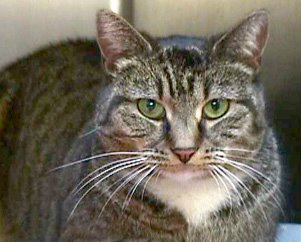Upper Respiratory Infections in Cats

Upper Respiratory Infections in Cats
by Linda Mar Veterinary Hospital
Your cat has just been diagnosed with an upper respiratory infection. This is an extremely common condition, especially in cats just acquired from any multi-cat situation (i.e. humane shelter, rescue facility, breeders cattery, a multi-cat household). It may be that you have an indoor/outdoor cat and a brief encounter with another cat allowed contact with the virus. Or it may be that your cat never leaves the home but you made contact with a cat with a cold and managed to transmit the virus on your hands and clothing.
Signs
Cat colds will cause sneezing, coughing, nasal and eye discharge. If only affected by the virus, the quality of the discharge is usually clear and watery. However, secondary bacterial infections will cause the discharge to become thick with mucous and green or yellow colored in appearance.
Treatment
Like human colds, unfortunately, it is a virus, and there is no specific treatment for this condition. Nothing can be done to eliminate the virus from the body. The cat will usually do this on its own in a 1-3 week period. If it doesnt, there are concerns about the cats immune system and/or re-infection. Suppression from the feline leukemia virus (Felv) or feline AIDS virus (FIV) can cause a protracted bout with upper respiratory infections. Or it may be that re-infections may be occurring from other cats in the household. Sometimes, it simply takes longer for an individual to clear up from cold symptoms.
Antibiotics
When there are secondary bacterial infections, antibiotics can be helpful. These may be given systemically as pills or liquids, or topically as ointment or drops applied to the eyes, or topically as drops applied to the nose. Supportive care is important.
Medications
Decongestants are sometimes useful and for this reason, an over-the-counter anti-histamine chlorpheniramine (Chlor-Trimeton) may be recommended. Another over-the-counter item that can be helpful for congested cats is "Little Noses", a pediatric formulation containing phenylephrine (Neo-synephrine) 1% nasal solution. These drops applied to cats nostrils can help clear nasal passages and make the cat more comfortable.
Hydration
Maintaining hydration by ensuring sufficient fluids are taken in by the cat is critical. This can be done either by giving fluids by mouth with a syringe or by mixing extra water in with canned food. Occasionally, it may be necessary to give fluids subcutaneously with a sterile solution (usually lactated Ringers) given under the skin. Your veterinarian can do this or if it will be needed for an extended period of time, you can be shown how to do this so it can be done at home.
Nutrition
Ensuring adequate nutrition is important. Canned food, especially warmed up, can increase palpability and smelly fish based foods are helpful to cats with a decreased sense of smell from the cold. Baby food (any of the meat based) is sometimes easier to swallow for some cats with colds. Note that baby food is not meant to be given exclusively nor long term since nutritional deficiencies will arise by doing so. However, it can be helpful short term to get a cat to eat something. Sometimes, forced feedings are necessary. Hills A/D (available from your veterinarian) is a balanced, nutritious food that can be easily drawn up via a syringe and given by mouth. It also has a soft consistency and is easy to swallow. Appetite stimulants such as low doses of valium or an anti-histamine, cryptoheptadine (Periactin) can be used to encourage food consumption.
Maintenance
Keeping the nasal passage and eyes clean and free of build-up of secretions is important. This may necessitate cleaning several times a day with a soft cloth or cotton swabs, moistened with warm water. A form of nebulization, the "steam effect" can be helpful, and this is achieved by placing the cat in a steamed bathroom (easily done when taking a shower).
Prevention
There are some simple precautions that can help minimize the course of disease for the affected cat and decrease the exposure to other cats in the household. Note there is no indication that colds can spread between humans and cats. Nonetheless, especially after handling the cats nasal or eye secretions, thorough hand washing is indicated.
Cat colds are very contagious between cats, both aerosolized and on items. For this reason, it is important, if possible, to isolate the affected cat away from the others. Sometimes, by the time a cat shows signs, it may be too late for the other cats who may have already been exposed. All other cats in the household should be monitored for sneezing and eye and nasal discharge. To minimize the spread of the virus, it is important, too, to wash all items such as bedding and food and water bowls that the affected cat has frequented. Even washing your hands is important to limit the spread of the virus when touching different cats in the household.
If you have any questions about this disease and its treatment, dont hesitate to contact your veterinarian.
The above is general veterinary information. Do not begin any course of treatment without consulting your regular veterinarian. All animals should be examined at least once every 12 months.
Linda Mar Veterinary Hospital and its cat-only affiliate, Coastal Cat Clinic, are small animal practices located in Pacifica, California. To find a veterinarian or to learn more about the vet clinic and our staff, visit:[http://lindamarvet.com/]





